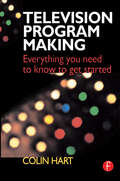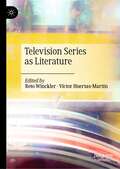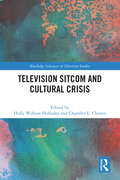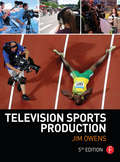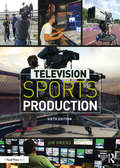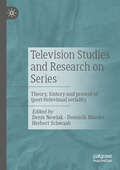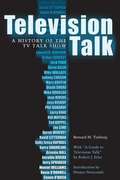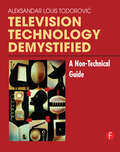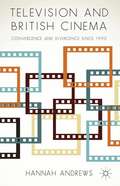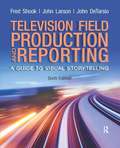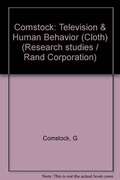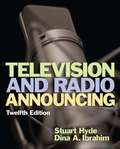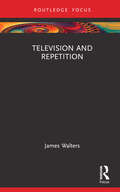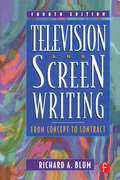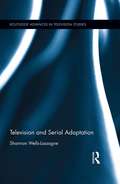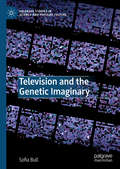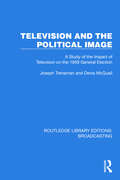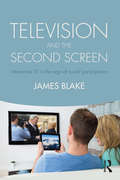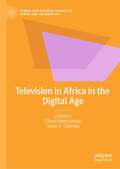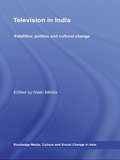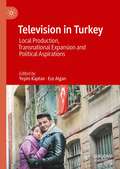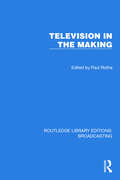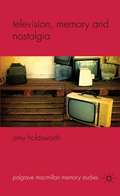- Table View
- List View
Television Program Making: Everything you need to know to get started
by Colin HartThis book is for anyone starting out or hoping to work in the ever-expanding world of television and video. Everyone involved in a TV or video production is contributing to the program making process. They all need to know and understand how it happens. Whatever you want to end up doing, whether you are part way through a course or starting from scratch, this book gives you all the essential information you will need. It takes a practical, step-by-step approach, based on the author's own 25-year experience of producing, writing and directing for broadcast television and the corporate sector on both video and film. It describes the roles people perform, the equipment they use and what it does. In simple, easy-to-read language it explains the grammar of shooting and editing and offers first-hand advice on treatments, scripts and budgets. As well as covering the technical aspects of both single and multi-camera production, it also looks at the editorial elements that create a successful program. With practical examples it demonstrates how best to turn ideas into reality, how to obtain successful interviews and how to put together programs that work. Colin Hart has his own production company making programs for corporate clients. He trained as a single and multi-camera director in local televison news and for ten years worked in BBC Current Affairs producing and directing for Nationwide and The Money Programme.
Television Publics in South Asia: Mediated Politics and Culture
by S.M. Shameem Reza and Ratan Kumar RoyTelevision has a prime role to play in the formation of discursive domains in the everyday life of South Asian publics. This book explores various television media practices, social processes, mediated political experiences and everyday cultural compositions from Afghanistan, Bangladesh, India, Nepal, Pakistan and Sri Lanka. With the help of country specific case studies, it captures broad range of themes which foreground the publics and their real-life experiences of television in the region. The essays in this book discuss gendered television spaces; women seeking solace from television in pandemic; the taboo in digital tv dramas; television viewership and localizing publics; changing viewership from television to OTT; news and public perception of death; re-defining ‘the national’; theatrical television; and post truth television news, among other key issues. Rich in ethnographic case studies, this volume will be a useful resource for scholars and researchers of media and communication studies, journalism, digital media, South Asian studies, cultural studies, sociology and social anthropology.
Television Series as Literature
by Reto Winckler Víctor Huertas-MartínThis book explores how television series can be understood as a form of literature, bridging the gap between literary and television studies. It goes beyond existing adaptation studies and narratological approaches to television series in both its scope and depth. The respective chapters address literary works, themes, tropes, techniques, values, genres, and movements in relation to a broad variety of television series, while drawing on the theoretical work of a host of scholars from Simone de Beauvoir and Yuri Lotman to Ted Nannicelli and Jason Mittel, and on critical approaches ranging from narratology and semiotics to empirical sociology and phenomenology. The book fosters new ways of understanding television series and literature and lays the groundwork for future scholarship in a number of fields. By questioning the alleged divide between television series and works of literature, it contributes not only to a better understanding of television series and literary texts themselves, but also to the development of interdisciplinary scholarship in the humanities.
Television Sitcom and Cultural Crisis (Routledge Advances in Television Studies)
by Holly Willson Holladay Chandler L. ClassenThis volume demonstrates that television comedies are conduits through which we might resist normative ways of thinking about cultural crises.By drawing on Gramscian notion of crisis and the understanding that crises are overlapping, interconnected, and mutually constitutive, the essays in this collection demonstrate that situation comedies do more than make us laugh; they also help us understand the complexities of our social world’s moments of crisis. Each chapter takes up the televisual representation of a modern cultural crisis in a contemporary sitcom and is grounded in the extensive body of literature that suggests that levity is a powerful mechanism to make sense of and cope with these difficult cultural experiences.Divided into thematic sections that highlight crises of institutions and systems, identity and representation, and speculation and futurism, this book will interest scholars of media and cultural studies, political economy, communication studies, and humor studies.
Television Sports Production
by Jim OwensUnlike a studio production, many factors can adversely affect your television sports shoot including weather, lighting, and natural sound. A successful shoot is dependent on extensive planning, careful budgetting, technology, location, and a thorough understanding of the intricacies of the sport itself. With so much at stake, why not learn from an expert? In Television Sports Production, Fifth Edition Jim Owens walks you through the planning, set-up, directing, announcing, shooting, and editing involved with covering a sports event. This manual gives you the tools to effectively cover sports ranging such as football, soccer, and basketball. Tips and advice on using mobile units, cameras, audio equipment, and lighting rigs will enable you to produce live or recorded coverage like an expert and capture professional-quality footage on the first take. After all, there are no instant replays! This new edition has been updated to include: Techniques used by producers to capture the essence of individual Tips on shooting in 3D, 5D, 4k and 8K Coverage using surround sound and the second screen Extras such as camera and microphone diagrams and an easy-reference glossary
Television Sports Production
by Jim OwensIn this sixth edition of Television Sports Production, regional Emmy Award-winning producer Jim Owens walks readers through the planning, setup, directing, announcing, shooting, and editing involved in covering a sports event. Originally written as a training guide for entry-level broadcast staff at the Olympics, this manual gives readers the tools they need to effectively cover sports from ice skating to motorcycle racing. Throughout, Owens breaks down all aspects of the production process, revealing the techniques that producers and directors use to bring sports to a worldwide audience. Chapters further include tips and advice on using the latest technologies and tools such as production trucks, REMIs, smart phones, mobile units, cameras, audio equipment, and lighting rigs. Featuring new instructive illustrations and sample forms, as well as testimonials from experienced professionals in the business, this new edition gives readers an inside look at how the experts produce live or recorded television and sports coverage. This comprehensive book is essential reading for intermediate and advanced students looking to learn how to successfully produce sports broadcasting.
Television Studies and Research on Series: Theory, history and present of (post-)televisual seriality
by Dominik Maeder Denis Newiak Herbert SchwaabTelevision series enjoy an unbroken - popular as well as scholarly - attention. It is surprising, however, that in works on seriality in media and cultural studies, approaches to television studies and television history still play a rather minor role. Yet seriality should always be thought of in terms of television, since the two have always been inextricably interwoven - economically, technically and aesthetically. But what else constitutes the serial in television and how does it change its face in times of digitalization, streaming and interactivity? Is it possible to think of a genuine serial theory of the televisual - and what, in turn, can be learned from this for seriality beyond television? The essays in this volume contribute to shedding new light on the serial as a core principle of television and to providing new impulses for a television theory of the serial on the basis of diverse examples from the current range of television series.
Television Studies: The Basics (The Basics)
by Toby MillerTelevision Studies: The Basics is a lively introduction to the study of a powerful medium. It examines the major theories and debates surrounding production and reception over the years and considers both the role and future of television. Topics covered include: broadcasting history and technology institutions and ownership genre and content audiences Complete with global case studies, questions for discussion, and suggestions for further reading, this is an invaluable and engaging resource for those interested in how to study television.
Television Talk: A History of the TV Talk Show
by Bernard M. TimbergFlip through the channels at any hour of the day or night, and a television talk show is almost certainly on. Whether it offers late-night entertainment with David Letterman, share-your-pain empathy with Oprah Winfrey, trash talk with Jerry Springer, or intellectual give-and-take with Bill Moyers, the talk show is one of television's most popular and enduring formats, with a history as old as the medium itself.
Television Technology Demystified: A Non-technical Guide
by Aleksandar Louis Todorovic"Television Technology Demystified" is written for non-technical television production professionals. Journalists, program producers, camera persons, editors, and other television professionals need to know how equipment works, which performance levels are achievable, how to evaluate the technical quality of picture and sound, and other aspects of production; this book presents these and other essential concepts in a simple and non-mathematical way. Aleksandar-Louis Todorovic, a highly respected and well-known figure in the broadcasting community, has succeeded in making complex technology understandable.
Television and British Cinema
by Hannah AndrewsUndertaking a thorough and timely investigation of the relationship between television and cinema in Britain since 1990, Hannah Andrews explores the convergence between the two forms, at industrial, cultural and intermedial levels, and the ways in which the media have also been distinguished from one another through discourse and presentation.
Television and Field Reporting (Sixth Edition)
by Fred Shook John Larson John DetarsioUpdated in its 6th edition, Television Field Production and Reporting provides an exciting introduction to the art of visual storytelling. Endorsed by the National Press Photographers Association, it focuses on the many techniques and tools available in television today.
Television and Human Behavior
by George Comstock Steven Chaffee Nathan KatzmanStudies the impact of television on viewers' habits, activities, and attitudes, examining patterns of viewing, concepts that television imposes on public consciousness, and effects on children, blacks, and the poor
Television and Radio Announcing, Twelfth Edition
by Stuart Hyde Dina A. IbrahimThe digital revolution has significantly changed broadcast technology. The 12th edition of Television and Radio Announcing reflects new trends in the field, such as the reconfiguration of electronic media production practices and distribution models. The internet and social media have opened up new access to production and new methods of distribution, such as YouTube, Facebook, Twitter, and podcasts. The 12th edition addresses the realities of students who live in this new era.
Television and Repetition
by James WaltersResisting some of the negative connotations that repetition can attract, this book illustrates how it has been used as a catalyst for creative expression across a range of television genres. Divided into two parts, the first three chapters contextualise repetition within related media and critical debates, before locating it as an important facet of television that is worth exploring in detail. The final three chapters discuss specific television shows that incorporate repetition creatively within their narrative structure and aesthetic composition, ranging from The Royle Family and Doctor Who to I May Destroy You and This is Going to Hurt. In each case, James Walters argues that repetition emerges as crucial to the expression of key themes and ideas, thus becoming a structural and compositional element itself. Exploring the ways in which repetition has featured in the work of figures such as Umberto Eco, Raymond Bellour and Bruce Kawin, and has influenced the approaches of television scholars like Raymond Williams, Roger Silverstone and John Ellis, this book is essential reading for scholars and students of film, television and media studies.
Television and Screen Writing: From Concept to Contract
by Richard A BlumNow in its fourth edition, Television and Screen Writing: From Concept to Contract is a classic resource for students and professionals in screenwriting and television writing. This book will teach you how to become a creative and marketable writer in every professional arena - including major studios, production companies, networks, cable and pay TV, animation, and interactive programs. Specific techniques and script samples for writing high-quality and producible "spec" scripts for theatrical motion pictures, the sitcom series, one-hour dramatic series, longform television, soaps, talk show, variety, animation, interactive and new media are provided. Television and Screen Writing: From Concept to Contract, Fourth Edition also offers a fully detailed examination of the current marketplace, and distinct strategies for marketing your scripts, from registering and copyrighting the script to signing with an agent. This new edition has been expanded to include the most up-to-date creative and professional script samples, marketing resources, and practical information possible. The companion website (www.focalpress.com/companions) offers a wide range of contacts and resources for you to explore, and Internet links to professional resources. There is also an Annotated and Selected Bibliography for your reference
Television and Serial Adaptation (Routledge Advances in Television Studies)
by Shannon Wells-LassagneAs American television continues to garner considerable esteem, rivalling the seventh art in its "cinematic" aesthetics and the complexity of its narratives, one aspect of its development has been relatively unexamined. While film has long acknowledged its tendency to adapt, an ability that contributed to its status as narrative art (capable of translating canonical texts onto the screen), television adaptations have seemingly been relegated to the miniseries or classic serial. From remakes and reboots to transmedia storytelling, loose adaptations or adaptations which last but a single episode, the recycling of pre-existing narrative is a practice that is just as common in television as in film, and this text seeks to rectify that oversight, examining series from M*A*S*H to Game of Thrones, Pride and Prejudice to Castle.
Television and the Genetic Imaginary (Palgrave Studies in Science and Popular Culture)
by Sofia BullThis book examines the complex ways in which television articulates ideas about DNA in the early 21st century. Considering television’s distinct aesthetic and narrative forms, as well as its specific cultural roles, it identifies TV as a key site for the genetic imaginary. The book addresses the key themes of complexity and kinship, which function as nodes around which older essentialist notions about the human genome clash with newly emergent post-genomic sensibilities. Analysing a wide range of US and UK programmes, from science documentaries, science fiction serials and crime procedurals, to family history programmes, sitcoms and reality shows, Television and the Genetic Imaginary illustrates the extent to which molecular frameworks of understanding now permeate popular culture.
Television and the Political Image: A Study of the Impact of Television on the 1959 General Election (Routledge Library Editions: Broadcasting #36)
by Denis McQuail Joseph TrenamanWas the 1959 UK General Election the first television election? Could television be used to create a Party ‘image’? Television and the Political Image (1961) provides answers to both these questions. It surveys two constituencies, interviewing the same cross-section of electors before and after the election campaign, and analyses and compares the campaigns as conducted by television, radio, the Press, and through the work of the local Parties. Various effects of the political barrage are measured and attributed to their sources; such effects include changes in voting intention during the course of the election campaign, changes in attitudes to Parties and their leaders, and changes in what the voter knows of the parties’ policies.
Television and the Second Screen: Interactive TV in the age of social participation
by James BlakeTelevision is changing almost beyond recognition. In the battle for consumers, social media sites, smart phones and tablets have become rivals to traditional linear TV. However, audiences and producers are also embracing mobile platforms to enhance TV viewing itself. This book examines the emerging phenomenon of the second screen: where users are increasingly engaging with content on two screens concurrently. The practice is transforming television into an interactive, participatory and social experience. James Blake examines interactive television from three crucial angles: audience motivation and agency, advances in TV production and the monetisation of second screen content. He also tracks its evolution by bringing together interviews with more than 25 television industry professionals - across the major UK channels - including commissioning editors, digital directors, producers and advertising executives. These reveal the successes and failures of recent experiments and the innovations in second screen projects. As the second screen becomes second nature for viewers and producers, the risks and opportunities for the future of television are slowly beginning to emerge. Television and the Second Screen will offer students and scholars of television theory, industry professionals and anyone with an abiding interest in television and technology, an accessible and illuminating guide to this important cultural shift.
Television in Africa in the Digital Age (Gender and Cultural Studies in Africa and the Diaspora)
by Gilbert Motsaathebe Sarah H. ChiumbuThis book places television in Africa in the digital context. It address the onslaught of multimedia platforms, digital migration and implication of this technology for society. The discussions in the chapters contained in this book encompass a wide range of issues such as digital disruption of television news, internet television and video on demand platforms, adaptations, digital migration, business strategies and management approaches, PBS, consumption patterns, scheduling and programming, evangelical television, and many others. The book is an important reading for academics, students and television practitioners. It offers an insightful view of television in Africa.
Television in India: Satellites, Politics and Cultural Change (Media, Culture and Social Change in Asia)
by Nalin MehtaThis book examines the development of television in India since the early 1990s, and its implications for Indian society more widely. Until 1991, India possessed only a single state-owned television channel, but since then there has been a rapid expansion in independent satellite channels which came as a complete break from the statist control of the past. This book explores this transformation, explaining how television, a medium that developed in the industrial West, was adapted to suit Indian conditions, and in turn has altered Indian social practices, making possible new ways of imagining identities, conducting politics and engaging with the state. In particular, satellite television initially came to India as the representative of global capitalism but it was appropriated by Indian entrepreneurs and producers who Indianized it. Considering the full gamut of Indian television - from "national" networks in English and Hindi to the state of regional language networks – this book elucidates the transformative impact of television on a range of important social practices, including politics and democracy, sport and identity formation, cinema and popular culture. Overall, it shows how the story of television in India is also the story of India's encounter with the forces of globalisation.
Television in Turkey: Local Production, Transnational Expansion and Political Aspirations
by Yeşim Kaptan Ece AlganThis edited collection takes a timely and comprehensive approach to understanding Turkey’s television, which has become a global growth industry in the last decade, by reconsidering its geopolitics within both national and transnational contexts. The Turkish television industry along with audiences and content are contextualised within the socio-cultural and historical developments of global neoliberalism, transnational flows, the rise of authoritarianism, nationalism, and Islamism. Moving away from Anglo-American perspectives, the book analyzes both local and global processes of television production and consumption while taking into consideration the dynamics distinctive to Turkey, such as ethnic and gender identity politics, media policies and regulations, and rising nationalistic sentiments.
Television in the Making (Routledge Library Editions: Broadcasting #37)
by Paul RothaTelevision in the Making (1956) looks at television in its infancy, with essays by the leaders of the medium at the time, people who were forging new paths as they imagined and actioned the possibilities of television.
Television, Memory and Nostalgia
by Amy HoldsworthAn innovative and original new study, Television, Memory and Nostalgia re-imagines the relationship between the medium and its forms of memory and remembrance through a series of case studies of British and North American programmes and practices. These include ER , Grey's Anatomy , The Wire , Who Do You Think You Are? , and Life on Mars .
